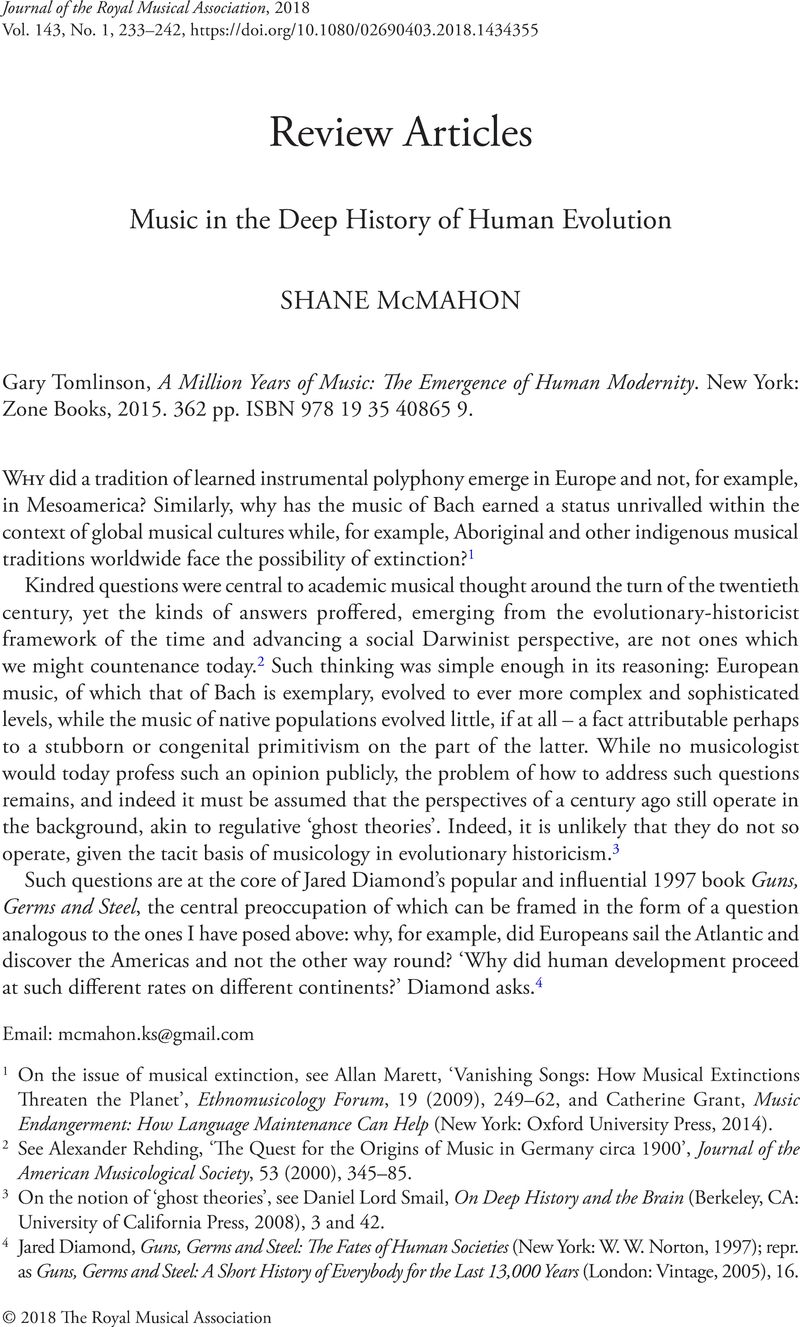No CrossRef data available.
Published online by Cambridge University Press: 01 January 2020

1 On the issue of musical extinction, see Allan Marett, ‘Vanishing Songs: How Musical Extinctions Threaten the Planet’, Ethnomusicology Forum, 19 (2009), 249–62, and Catherine Grant, Music Endangerment: How Language Maintenance Can Help (New York: Oxford University Press, 2014).
2 See Alexander Rehding, ‘The Quest for the Origins of Music in Germany circa 1900’, Journal of the American Musicological Society, 53 (2000), 345–85.
3 On the notion of ‘ghost theories’, see Daniel Lord Smail, On Deep History and the Brain (Berkeley, CA: University of California Press, 2008), 3 and 42.
4 Jared Diamond, Guns, Germs and Steel: The Fates of Human Societies (New York: W. W. Norton, 1997); repr. as Guns, Germs and Steel: A Short History of Everybody for the Last 13,000 Years (London: Vintage, 2005), 16.
5 Diamond, Guns, Germs and Steel, 25.
6 In addition to Smail, On Deep History and the Brain, and Andrew Shryock and Daniel Lord Smail, Deep History: The Architecture of Past and Present (Berkeley, CA, and London: University of California Press, 2011), which elaborate upon the idea of deep history and associated methodological issues, some of the most striking examples, closely related to Tomlinson's work in their interdisciplinary methodology and chronological scope, are those of David Christian, Maps of Time: An Introduction to Big History (Berkeley, CA, and London: University of California Press, 2004); Robert N. Bellah, Religion in Human Evolution: From the Paleolithic to the Axial Age (Cambridge, MA, and London: Harvard University Press, 2011); E. J. Michael Witzel, The Origins of the World's Mythologies (New York and Oxford: Oxford University Press, 2012); and Clive Gamble, Settling the Earth: The Archaeology of Deep Human History (Cambridge and New York: Cambridge University Press, 2013).
7 In addition to implicit progressivism, contemporary musical historiography also strongly illustrates what Daniel Lord Smail refers to as the telescoping of history. See Smail, ‘History and the Telescoping of Time: A Disciplinary Forum’, French Historical Studies, 34 (2011), 1–6. Tomlinson has elsewhere referred to this historiographical phenomenon as ‘Presentism’. See his ‘Monumental Musicology’, Journal of the Royal Musical Association, 132 (2007), 349–74 (pp. 361–2).
8 The undermining of the historiographical plot-devices of revolution and rupture has gained significant ground over the past two decades. Influential here is the essay by Sally McBrearty and Alison S. Brooks, ‘The Revolution that Wasn't: A New Interpretation of the Origin of Modern Human Behaviour’, Journal of Human Evolution, 39 (2000), 453–563.
9 See Andrew Shryock and Daniel Lord Smail, ‘History and the “Pre”’, American Historical Review, 118 (2013), 709–37.
10 On how modern historiography is informed by the plots and narrative devices of sacred history, see Smail, On Deep History, 12–39. See also Eviatar Zerubaval, Time Maps: Collective Memory and the Social Shape of the Past (Chicago, IL, and London: University of Chicago Press, 2003), 11–36.
11 Tomlinson has previously broached some of these issues in ‘Vico's Songs: Detours at the Origins of (Ethno)musicology’, Musical Quarterly, 83 (1999), 344–77.
12 From Darwin to Robin Dunbar, non-specialist commentary on music in human evolution has often been marred by an imprecision of language which, as Tomlinson notes, such eminent figures would not have not tolerated in their own specialized areas (p. 114).
13 Steven Brown, ‘The “Musilanguage” Model of Music Evolution’, The Origins of Music, ed. Nils L. Wallin, Björn Merker and Steven Brown (Cambridge, MA: MIT Press, 2000), 271–300, and Steven Mithen, The Singing Neanderthals: The Origin of Music, Language, Mind and Body (London: Weidenfeld & Nicolson, 2005).
14 For recent examples illustrating the kind of deeply entrenched adaptationist view Tomlinson seeks to overturn (in this case, music as a mechanism of social bonding), see Robin Dunbar, ‘On the Evolutionary Function of Song and Dance’, Music, Language, and Evolution, ed. Nicholas Bannan (Oxford: Oxford University Press, 2012), 201–14, and the same author's Human Evolution (London: Pelican, 2014), 207–14.
15 Here, Tomlinson develops the ideas of the archaeologist Clive Gamble. The idea that such tools are a product of a mental template formed in advance implies a capacity for mental abstraction, thinking-at-a-distance and what Gamble calls a ‘release from proximity’ (p. 61). For Gamble, such a capacity is not otherwise attested in the archaeological record of the period under discussion.
16 In this sense, Tomlinson's work could be grouped with that of scholars attempting to reinvigorate an older tradition of historiography; see David Christian, ‘The Return of Universal History’, History and Theory: The Next Fifty Years, special theme issue no. 49, History and Theory, 49/4 (December 2010), 6–27. Although Tomlinson is unlikely to claim that he has written a ‘universal history’ of the kind robustly advocated by Christian, A Million Years of Music certainly provides a conceptual framework in which such a history (or series of histories) might be conceived.
17 The precise dating of the earliest migrations is still a matter of debate. The earliest date attested with certainty is c.11,000 BC. However, claims have been made that the earliest migrations may have occurred c.20,000 BC. For a convenient recent summary of these issues, see Marcel Kornfeld and Gustavo G. Politis, ‘Into the Americas: The Earliest Hunter-Gatherers in an Empty Continent’, The Oxford Handbook of the Archaeology and Anthropology of Hunter-Gatherers, ed. Vicki Cummings, Peter Jordan and Marek Zvelelbil (Oxford: Oxford University Press, 2014), 405–36. For the origins and development of mythological systems and their continued influence, see Witzel, The Origins of the World's Mythologies, esp. pp. 430–9.
18 See Gamble, Settling the Earth. Indeed, with significant overlap between them, A Million Years of Music is very profitably read alongside Gamble's deep history of hominin migration and settlement.